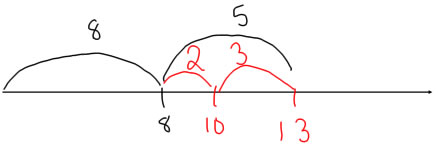For example, to figure out 8+5, we realize that 8+2=10

Then we partition 5 into 2+3, and take 2 from the 5 and give it to the 8 to make 10. This leaves us with 10+3:

So the sum is 13.
Make 10, or Add up using 10 is a derived facts strategy. That means children need to know some facts by hear before they can use a make 10 strategy.
The key facts for using a make 10 strategy are 8+2=10 and 9+1=10.
An example of the make 10 strategy is when adding 8+5, you use that 8+2=10, and decompose 5 into 2+3. Then you group the 2 with the 8 to get 8+5=(8+2)+3=10+3, then add 10 and 3 to get 13.
8+2=10
5=2+3
10+3=13
8+5=13
Representations
It's a good idea to have some ways of representing the make 10 strategy. Manipulatives and diagrams to clarify the make 10 strategy are a very good idea. Here are some ways to show the make 10 strategy with some appropriate materials.
With 10-frames
For example, to figure out 8+5, we realize that 8+2=10
Then we partition 5 into 2+3, and take 2 from the 5 and give it to the 8 to make 10. This leaves us with 10+3:
So the sum is 13.
An open number line is a very good way of showing the make 10 strategy for adding:

Being an open number line means that instead of writing onto the number line all of the numbers before you start, you write on just the ones you need in order to keep track of what you are doing. This number line diagram shows 8+5, and of course, the jump to 8 lands at 8, but it's not obvious where the jump of 5 will land. To figure that out, you have to break 5 into 2+3. The jump of 2 lands you right on 10, and jumping 3 from 10 lands you at the sum of 13.